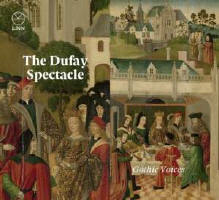Texte paru dans: / Appeared in: |
|
|
Outil de traduction ~ (Très approximatif) |
|
|
Reviewer: J.
F. Weber This collection of motets and chansons is titled The Dufay Spectacle, the program divided into sections titled “The Welcome,” “A Reflection,” “Solemn Celebration,” and “Playful Celebration.” The new year’s song Ce jour de l’an is used on six tracks as a song or an instrumental improvisation, for this song signifies a wedding on that day in Italy of the 1470s, just before the composer’s death in 1474. The first verse is sung by Stephen Charlesworth, the second verse by Catherine King, then three instrumental versions, the program concluding with a heavily accompanied version using all five singers and all four players. Both of the Buxheimer Orgelbuch versions of Se la face ay pale are given contrasting instrumental renditions, as is Portugaler. Je vous pri uses four unaccompanied voices; Las, que feray, Vergine bella, and Mon bien, m’amour have three unaccompanied voices. Six songs have one to three voices with instrumental accompaniment. Quel fronte signorille is a harp solo by Andrew Lawrence-King. Five motets are scattered among the songs and instrumental renditions, all sung after modest beginnings with overpowering instrumental accompaniment.
After 21 CDs on Hyperion, two on Avie, and an earlier issue on the present label, Gothic Voices has turned sharply away from the conviction of its first director, Christopher Page, that music of this period was sung without accompaniment. This is most evident in the concluding song and the five motets. But even Je me complains makes quite a noise with Andrew Lawrence-King’s regal accompanying three voices. The argument about instrumental accompaniment of early music has become something of a standoff since the early positions were clarified by Daniel Leech-Wilkinson in The Modern Invention of Medieval Music (Cambridge, 2002). Both positions are now represented (very well, in fact) on records. He showed that the 19th-century understanding of medieval polyphony as unaccompanied vocal music was accepted by Hugo Riemann in his Musik-Lexicon through the fifth edition of 1900, but reversed by the seventh edition of 1909. He then became an enthusiastic proponent of voices with instruments. Leading interpreters such as Safford Cape began turning toward some unaccompanied renditions in the early 1950s, but records offered far more accompanied early music than unaccompanied. Noah Greenberg and most others at the time were using instruments developed in the Renaissance and Baroque eras. The tide began to turn with Christopher Page’s article, “Machaut’s ‘pupil’ Deschamps on the performance of music,” in Early Music in 1977. After that, the more common difference was the use of no instruments vs. the use of medieval instruments. The Medieval Ensemble of London used only medieval instruments, but it disbanded in 1984 after the Davies brothers accepted Page’s position. The present program employs vihuela d’arco, fiddle, organ, regal, bray harp, psaltery, douçaine, shawm, and sackbut, similar to the list of instruments used by the Davies brothers. Recent unaccompanied versions of Dufay’s motets include Apostolo glorioso under Andrew Kirkman (22:2), Ecclesiae militantis under Lanfranco Menga (41:4), Salve flos Tuscae gentis with Ensemble Musica Nova (29:4), and O sancte Sebastiane and Vasilissa ergo gaude under Edward Wickham on Signum SIGCD 023. There are a few nice tracks here, but overall this program is an unfortunate departure for a long-admired group. | |
|
Support us financially by purchasing this disc from eiher one of these suppliers. Un achat via l'un ou l'autre des fournisseurs proposés contribue à défrayer les coûts d'exploitation de ce site. |
|
|
|
|
|
Cliquez l'un ou l'autre
bouton pour découvrir bien d'autres critiques de CD |
|




